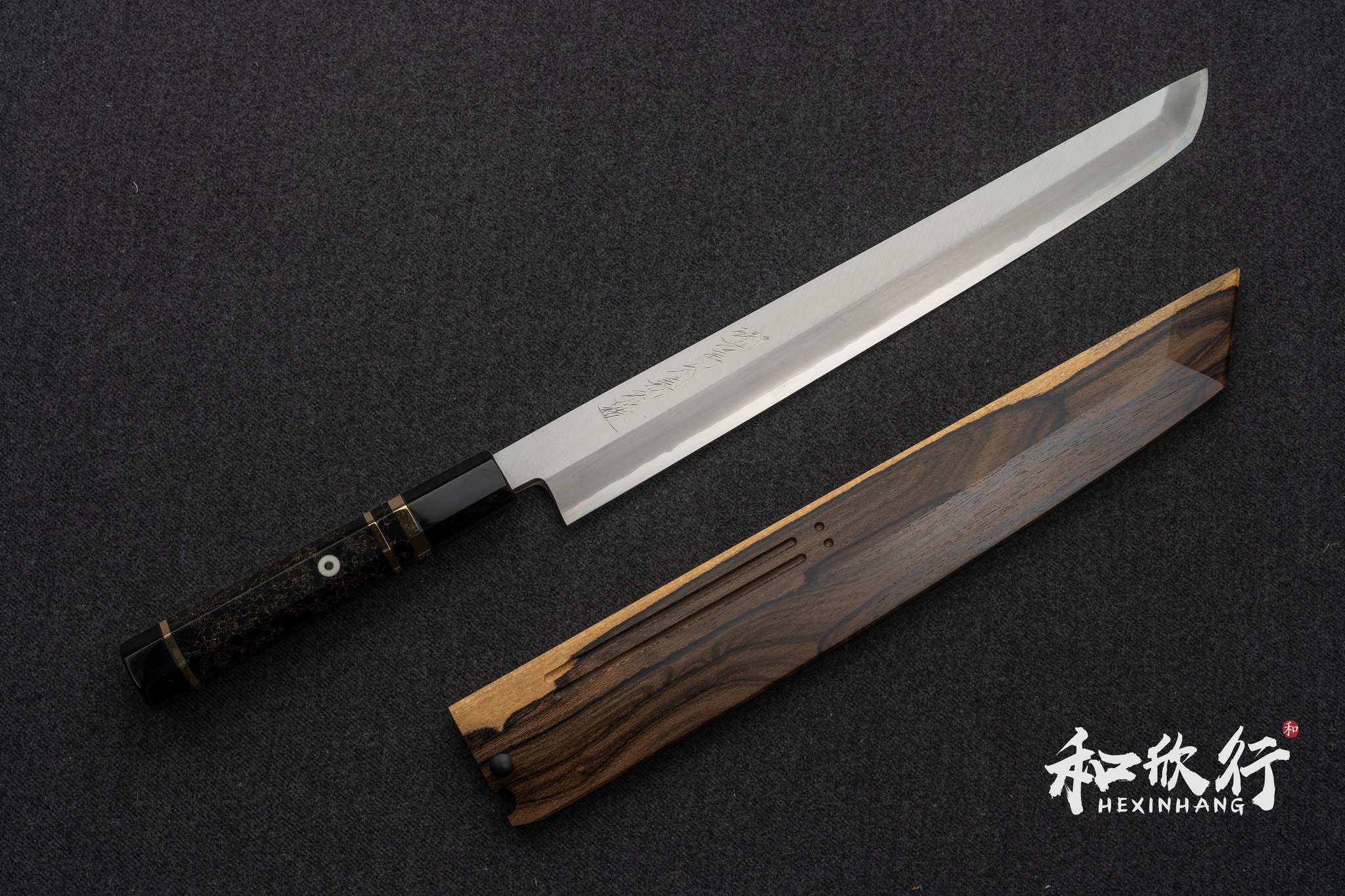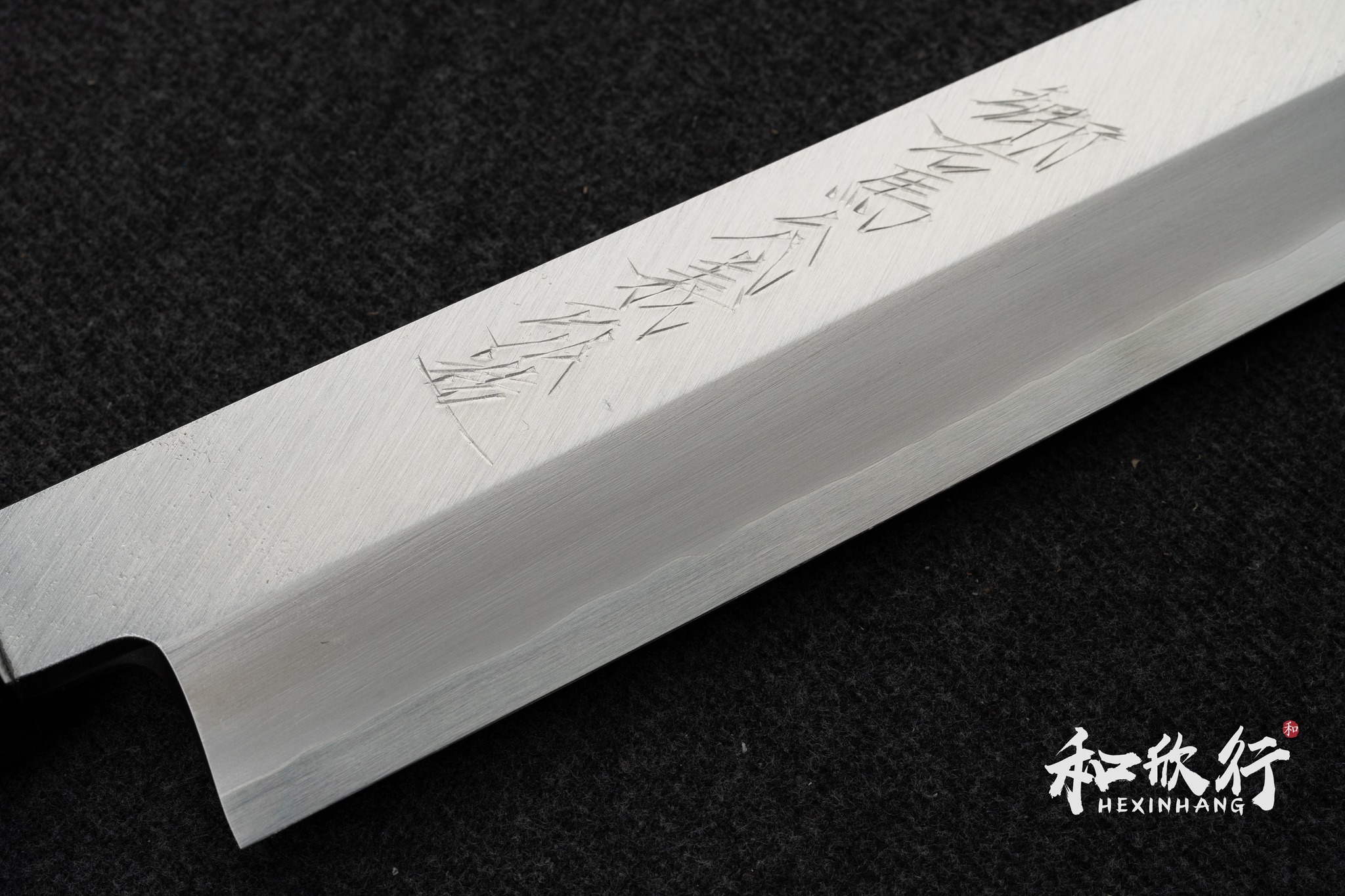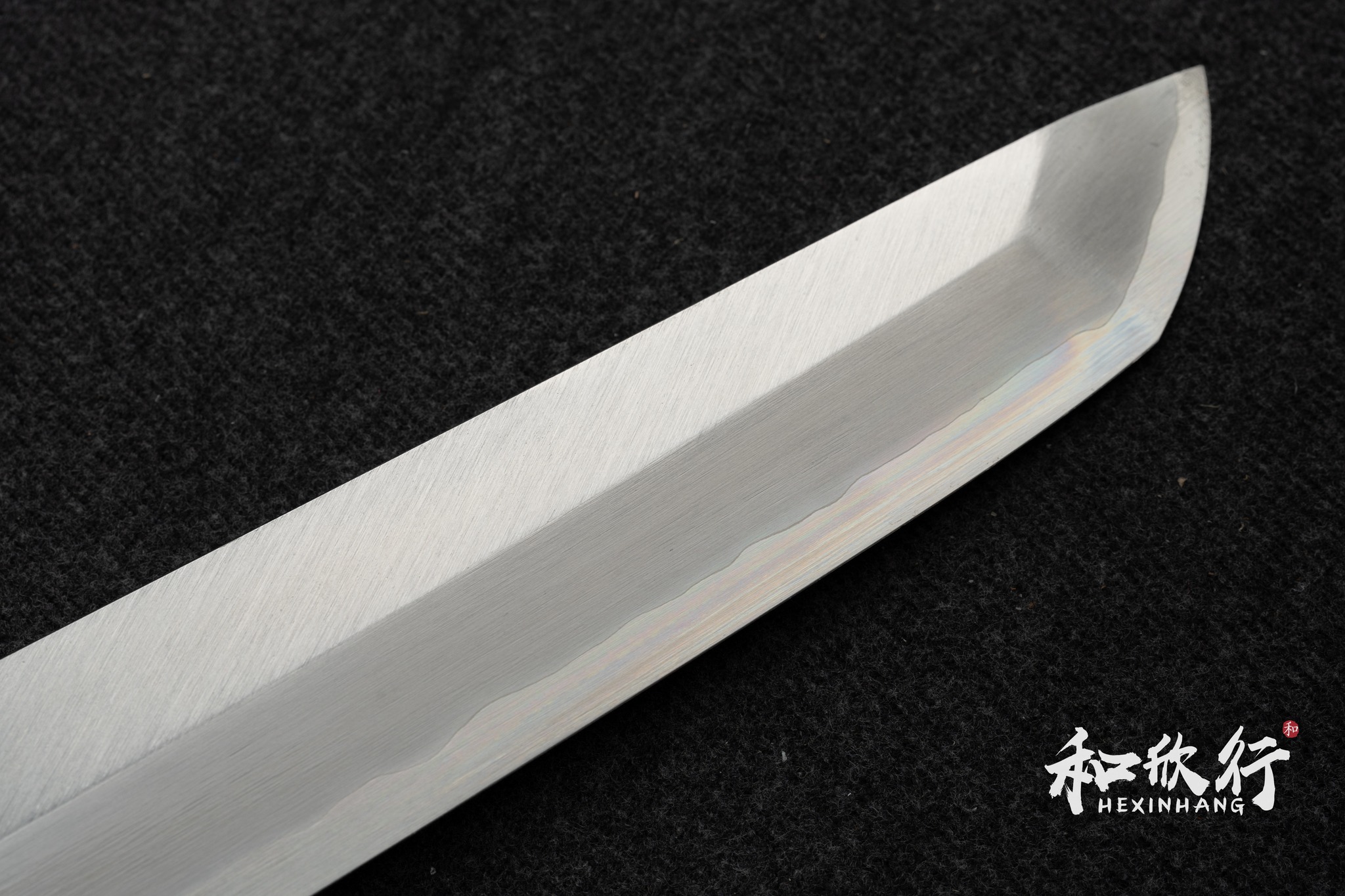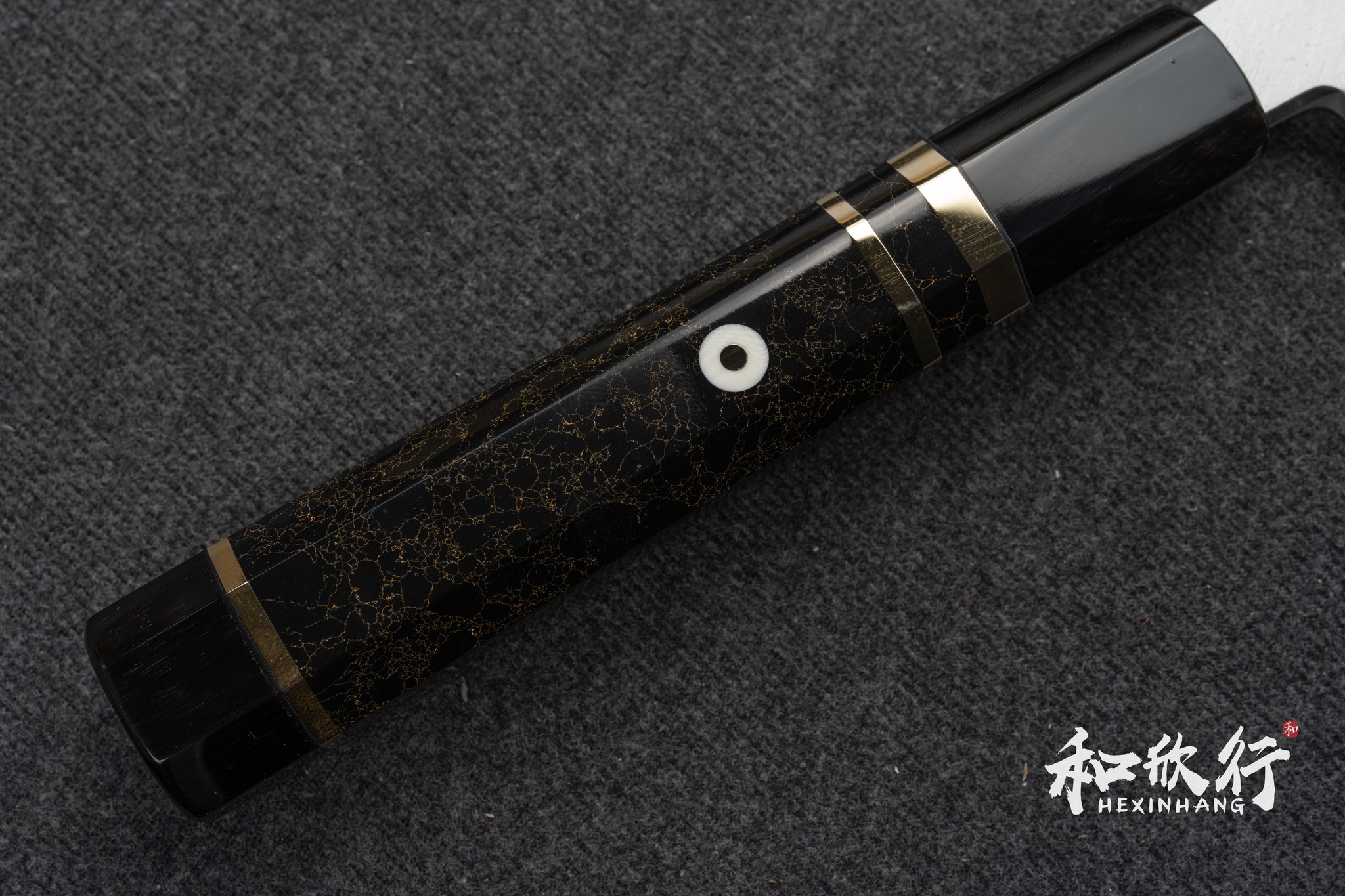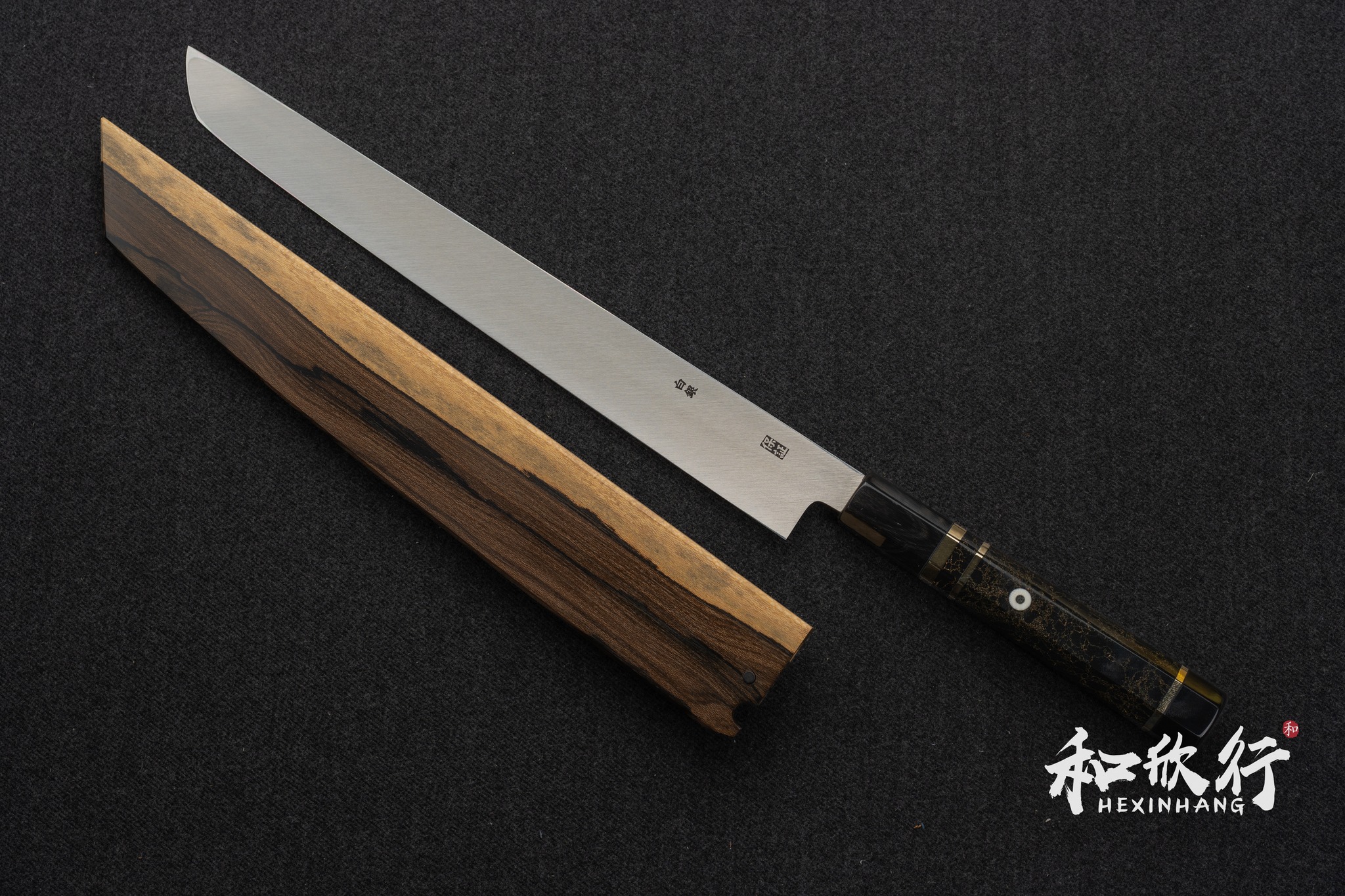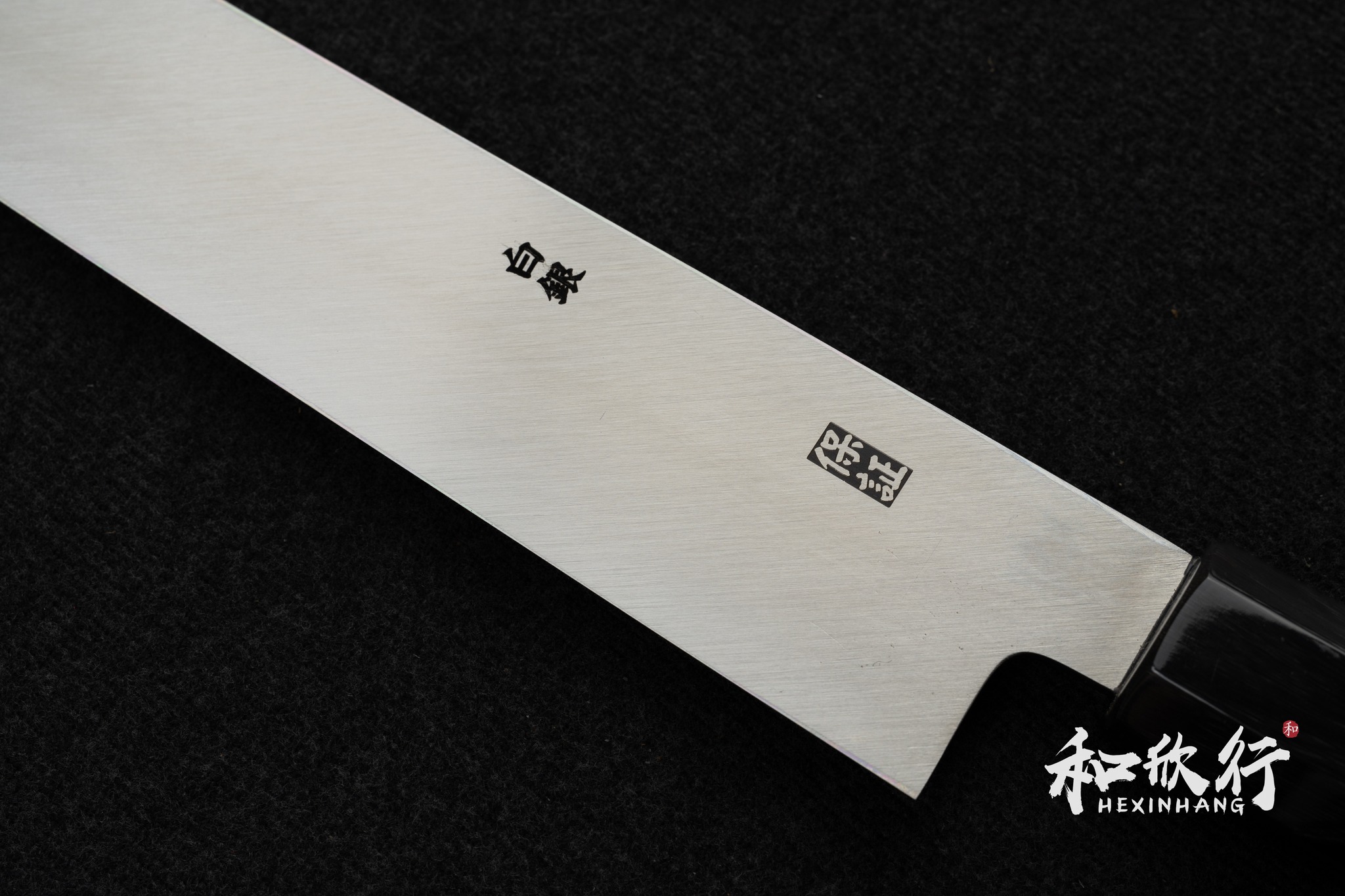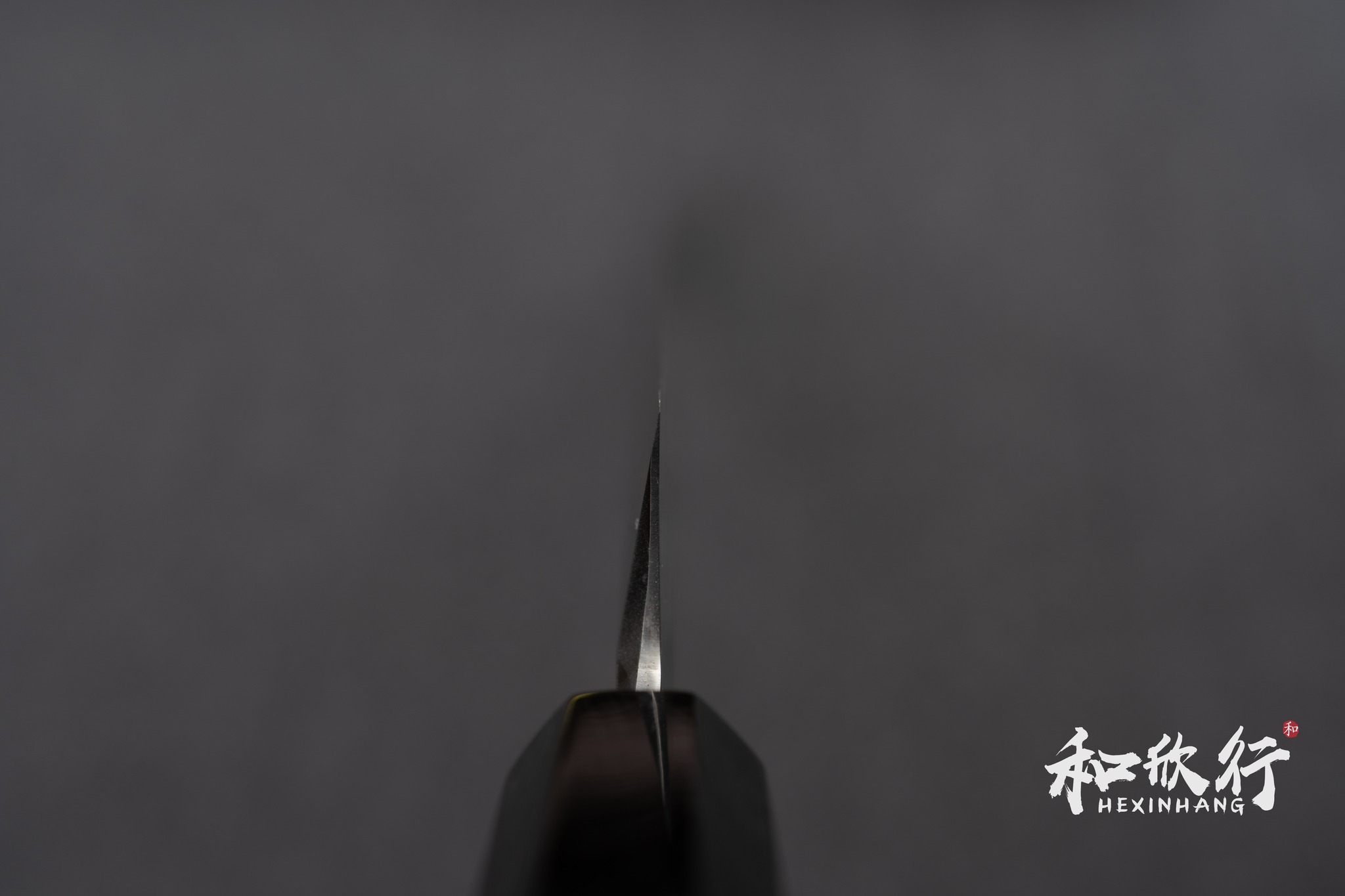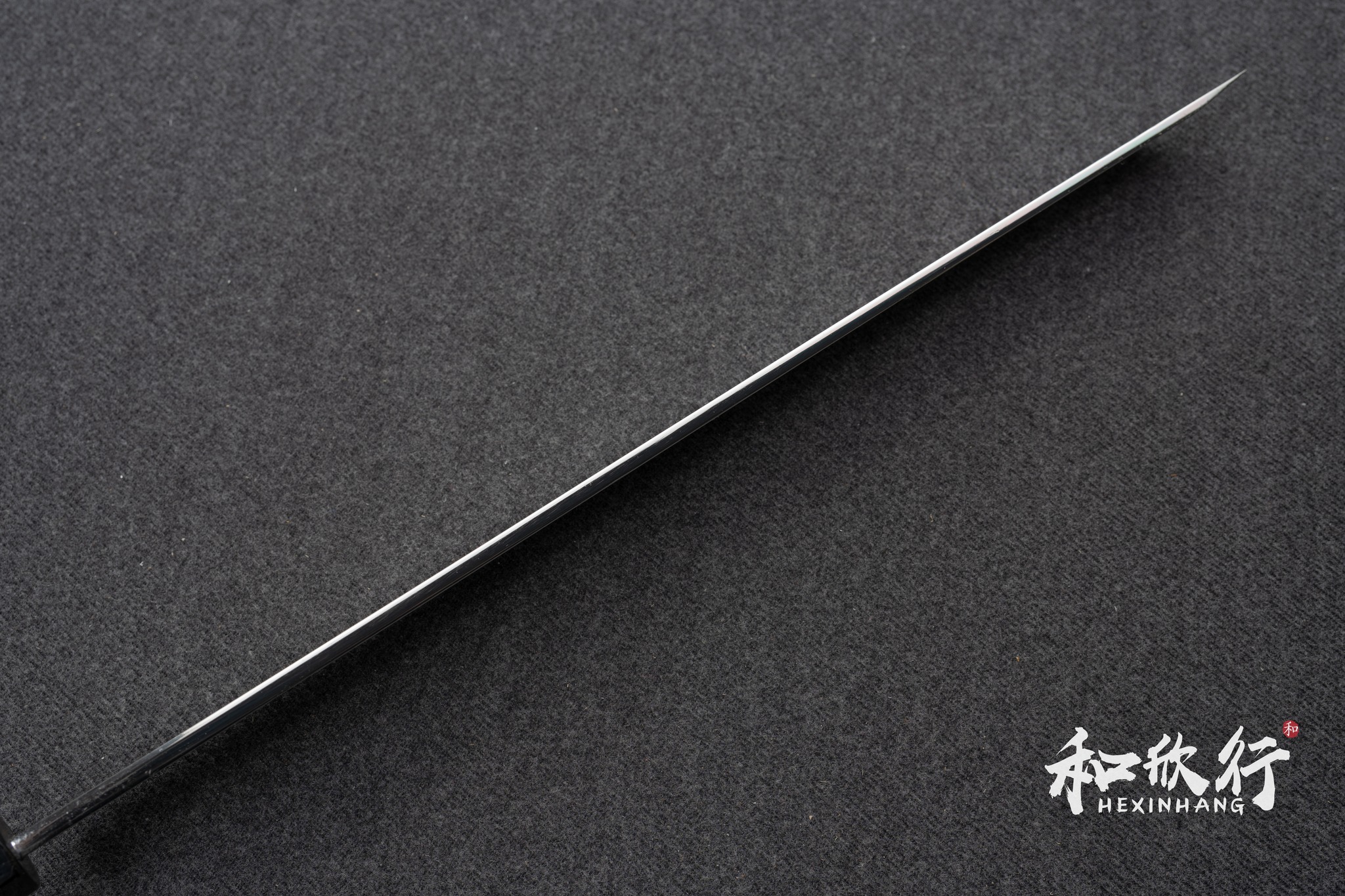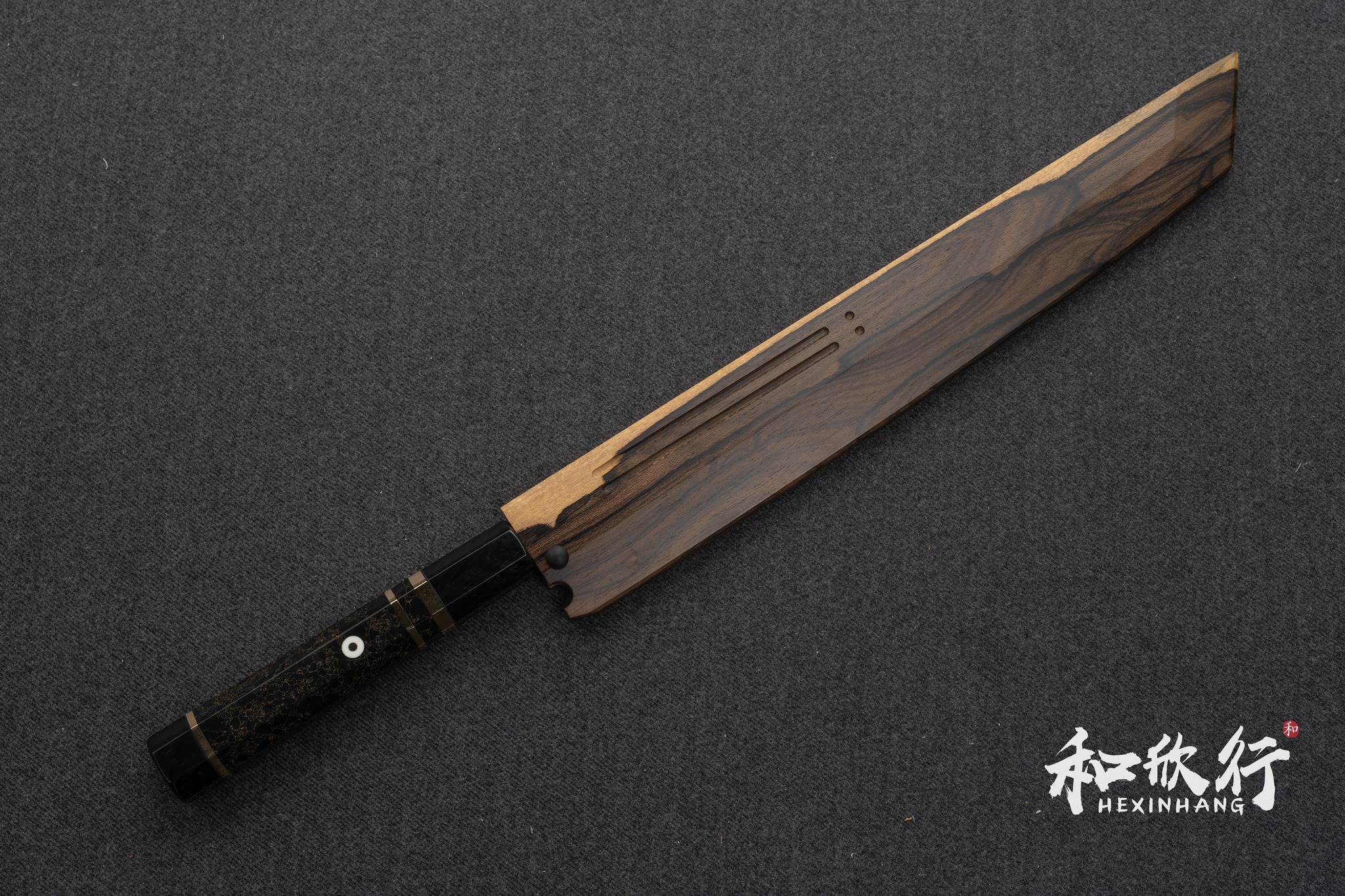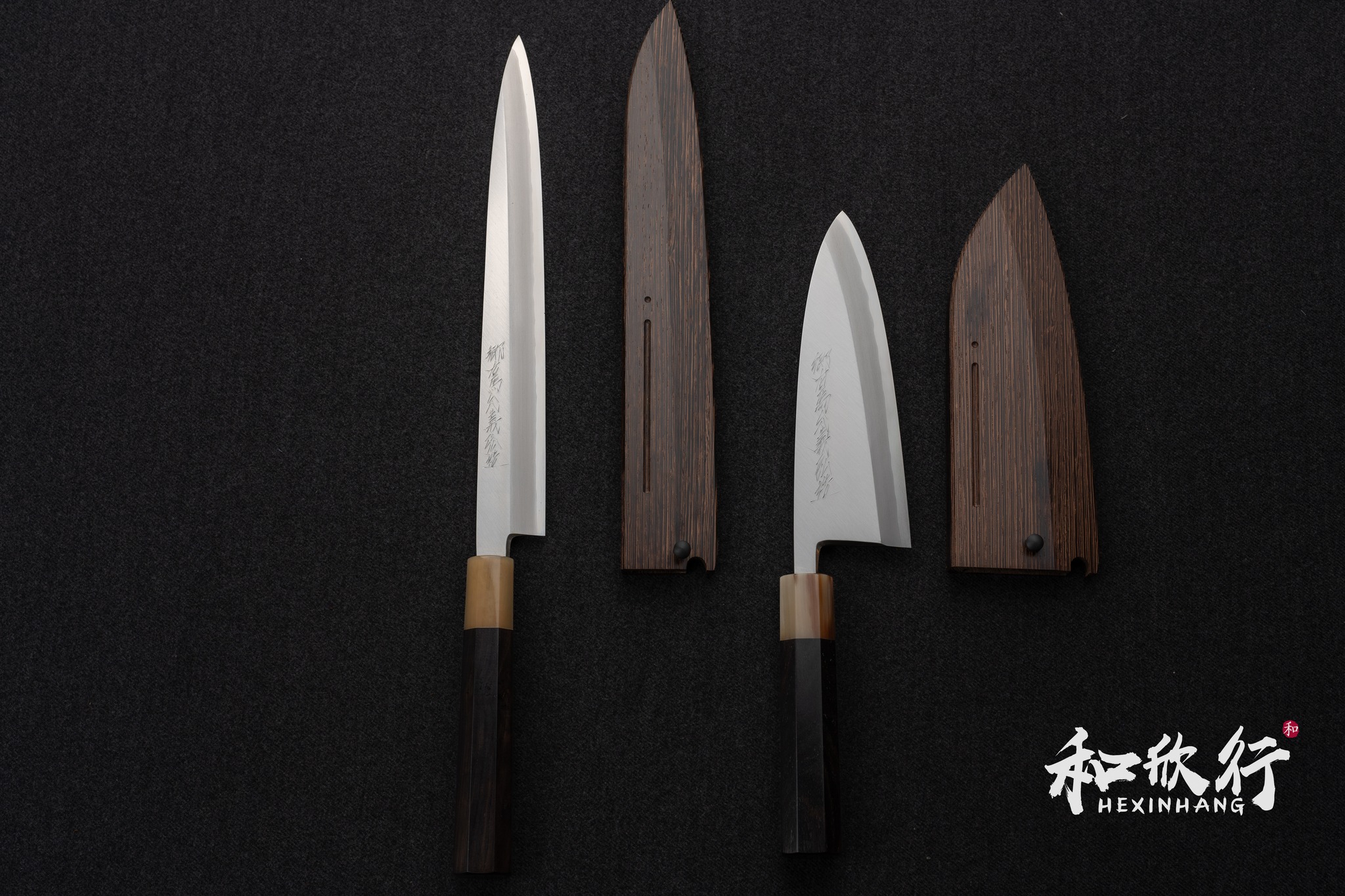
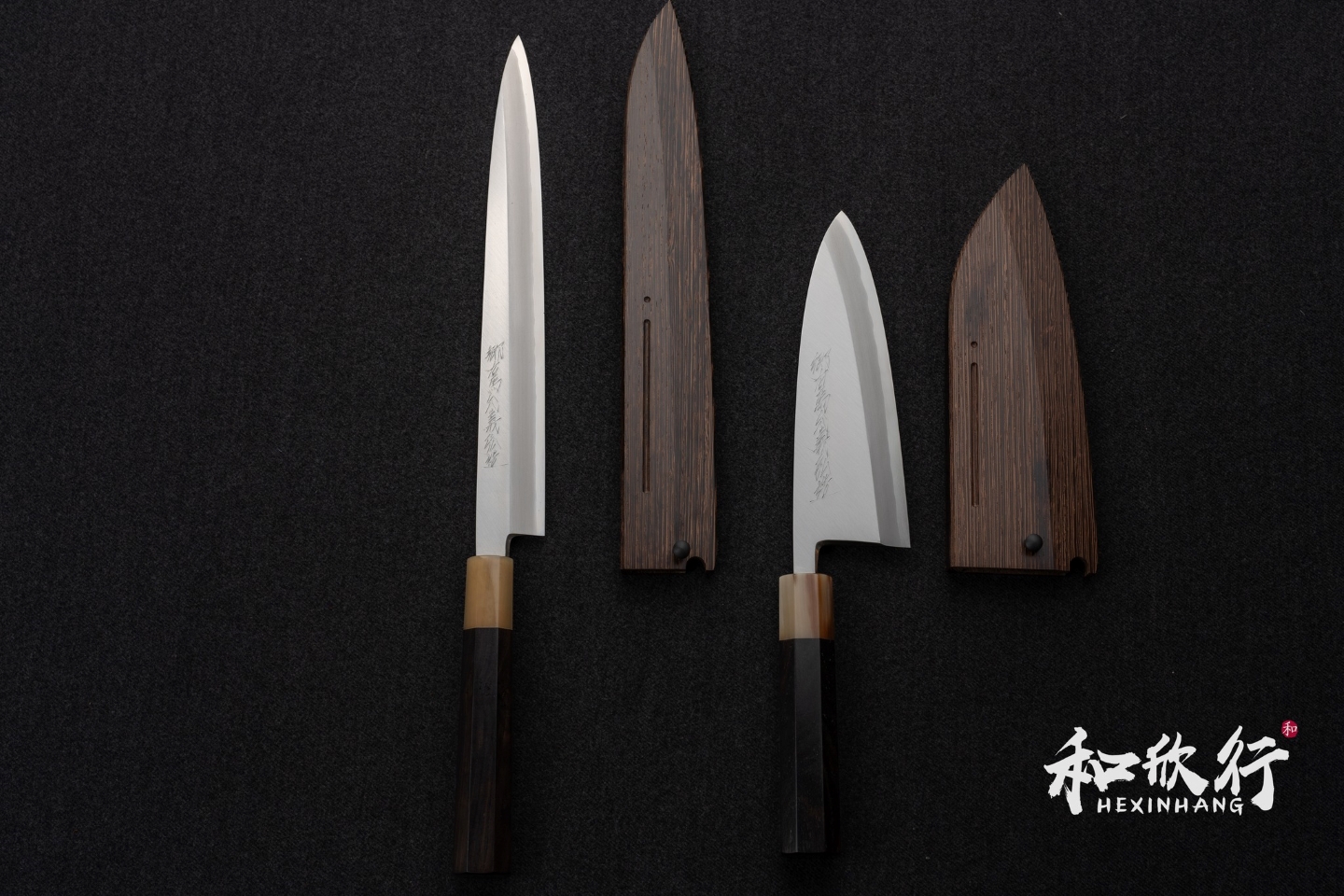
刀條現貨供應中
感謝訂製~
![]() 山脇刃物 郷右馬允義弘 作 銀三鋼 本霞 先丸蛸引 300mm / 330mm
山脇刃物 郷右馬允義弘 作 銀三鋼 本霞 先丸蛸引 300mm / 330mm
![]() 鋼材:銀三鋼 本霞
鋼材:銀三鋼 本霞
![]() 鍛製:傳統工藝士 山塚尚剛
鍛製:傳統工藝士 山塚尚剛
![]() 規格:300mm / 330mm
規格:300mm / 330mm
![]() 實際刃長:290mm / 320mm
實際刃長:290mm / 320mm
![]() 刃寬:3.5cm
刃寬:3.5cm
![]() 刃厚:4mm
刃厚:4mm
![]() 圖柄:黑金松石上下黑牛角三黃銅圈仿木釘
圖柄:黑金松石上下黑牛角三黃銅圈仿木釘
![]() 鞘:可加購訂製(圖為雙色黑柿木 +$4000)
鞘:可加購訂製(圖為雙色黑柿木 +$4000)
![]() 價格:
價格:
300mm - $19,500
330mm - $22,500
如搭配黑檀木白水牛角:
300mm - $17,500
330mm - $20,500
![]() 注意:刀柄口輪及木紋為天然材質,隨機出貨,顏色以實物為準。
注意:刀柄口輪及木紋為天然材質,隨機出貨,顏色以實物為準。
![]() 其他可選刀柄:
其他可選刀柄:
可加購升級刀柄,詳見
![]() 刀柄相簿 https://hexin-hang.com/album.php
刀柄相簿 https://hexin-hang.com/album.php
(木紋與水牛口輪顏色皆為天然隨機,無法指定)
山脇刃物製作所 郷右馬允義弘的歷史
![]() 5世紀至今的傳承
5世紀至今的傳承
![]() 在約 1500年前(西元401-500年,古墳時代),鍛鐵技術傳入堺地區。
在約 1500年前(西元401-500年,古墳時代),鍛鐵技術傳入堺地區。
![]() 自 平安時代末期 開始傳承技術,後來因製作煙草刀(煙斗煙管刀)聞名於世。
自 平安時代末期 開始傳承技術,後來因製作煙草刀(煙斗煙管刀)聞名於世。
![]() 江戶時代,堺因豐富的漁場發展出各種專業廚刀,特別是處理魚類的出刃包丁。
江戶時代,堺因豐富的漁場發展出各種專業廚刀,特別是處理魚類的出刃包丁。
![]() 今日的堺刀具,已成為專業廚師 90% 選用的工具,歷經長久演變與發展。
今日的堺刀具,已成為專業廚師 90% 選用的工具,歷經長久演變與發展。
![]() 名刀三作
名刀三作
在 室町時代,本阿彌光悦於《亨保名物帳》中記載:「世上有三把名刀」:
![]() 相州五郎入道正宗
相州五郎入道正宗
![]() 栗田口藤四郎吉光
栗田口藤四郎吉光
![]() 郷右馬允義弘
郷右馬允義弘
據說,大名家 若無這三把名刀之一,則無法維持身份與地位。
![]() 正國的煩惱
正國的煩惱
江戶時代末期,一位名為 正國 的刀匠,渴望模仿 郷右馬允義弘 的製刀風格,但始終無法達到。
![]() 奇異的景象:
奇異的景象:
某日,他參拜泉州住吉大社,看見三隻龜在水中嬉戲,靈感油然而生。
![]() 夢境啟示:
夢境啟示:
夢中,三隻龜優雅旋轉,最終化為鶴,飛往北陸道。受此啟發,正國拋棄雜念,全心投入製刀,終於打造出一把驚世之刃!
![]() 自稱「郷右馬允義弘」
自稱「郷右馬允義弘」
正國深信,這把刀已達到郷右馬允義弘的水準,於是自稱 郷右馬允義弘,並將技藝傳承至後代。
![]() 第二代 正次 傳承秘技,製作泉州傳統 本焼包丁。
第二代 正次 傳承秘技,製作泉州傳統 本焼包丁。
![]() 第三代 博次 在 昭和25年 註冊「郷右馬允義弘」為 山脇刃物製作所的代表品牌,此傳承至今仍持續發展。
第三代 博次 在 昭和25年 註冊「郷右馬允義弘」為 山脇刃物製作所的代表品牌,此傳承至今仍持續發展。
![]() 本文摘錄自山脇刃物製作所持有的「郷右馬允義弘由來の書」,由住吉大社權宮司敷田年博於昭和54年編撰。
本文摘錄自山脇刃物製作所持有的「郷右馬允義弘由來の書」,由住吉大社權宮司敷田年博於昭和54年編撰。
Ginsan Steel Hon-Kasumi Octagonal-Tip Takobiki 300mm / 330mm
🔪 Steel: Ginsan (Silver #3) – Hon-Kasumi Finish
🔪 Forged by: Traditional Craftsman Shogo Yamazuka
🔪 Size Options: 300mm / 330mm
🔪 Edge Length: 290mm / 320mm
🔪 Blade Width: 3.5cm
🔪 Blade Thickness: 4mm
🔪 Handle (pictured): Black Pinecone Composite with Black Buffalo Horn, Triple Brass Rings & Decorative Pins
🔪 Saya: Optional custom (pictured: Two-tone Black Persimmon +$4,000)
💰 Price
300mm – $19,500
330mm – $22,500
💰 With Ebony + White Buffalo Horn Handle
300mm – $17,500
330mm – $20,500
⚠ Note: Handle ferrule and wood grain are natural and vary by piece. Actual color and pattern may differ.
👉 Other handle upgrade options: Handle Gallery
(Wood grain & buffalo horn are natural, random, and cannot be specified.)
⏳ Forging Tradition Since the 5th Century
Around 401–500 AD (Kofun period), iron forging techniques arrived in Sakai.
From the late Heian era, Sakai’s blades gained fame through tobacco knives (for pipes).
In the Edo period, with rich fishing grounds nearby, Sakai developed specialized kitchen knives, especially Deba for fish preparation.
Today, over 90% of professional chefs in Japan use Sakai knives, a testament to centuries of refinement.
⚔ The “Three Famous Blades”
In the Muromachi period, Hon’ami Kōetsu (of the Hon’ami appraisal family) wrote in Hyōhō Meibutsuchō that the three legendary swords were:
Sōshū Gorō Nyūdō Masamune
Kurita-guchi Tōshirō Yoshimitsu
Gō Umanosuke Yoshihiro
It was said that no daimyo house could be recognized without possessing at least one of these three blades.
🔨 Masakuni’s Struggle & Vision
In the late Edo period, a smith named Masakuni yearned to replicate Yoshihiro’s style but could not.
A Strange Vision: While visiting Sumiyoshi Taisha Shrine, he saw three turtles swimming gracefully.
A Dream Revelation: That night, the turtles transformed into cranes and flew toward Hokuriku. Inspired, Masakuni abandoned distractions and forged tirelessly until he created a blade he believed equaled Yoshihiro’s.
🏯 Claiming the Name
Convinced of his success, Masakuni declared himself the successor of Gō Umanosuke Yoshihiro and passed his craft to later generations.
Second Generation (Masatsugu): Preserved the secret techniques and crafted traditional Honyaki knives of Senshū.
Third Generation (Hirotsugu): In 1950 (Shōwa 25), officially registered “Gō Umanosuke Yoshihiro” as the brand name of Yamawaki Hamono, still engraved on their knives today.
📖 Adapted from The Origin of Gō Umanosuke Yoshihiro, compiled in 1979 by Toshihiro Shikida, Deputy Chief Priest of Sumiyoshi Taisha Shrine.
